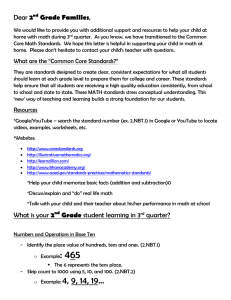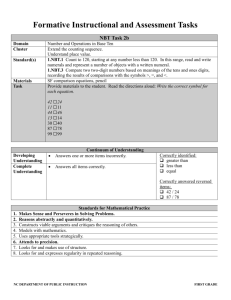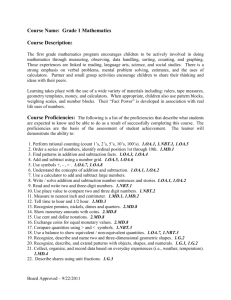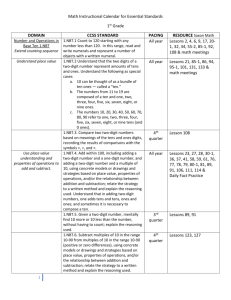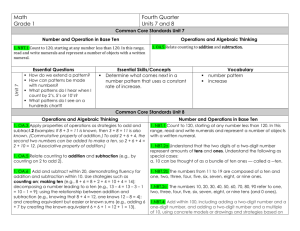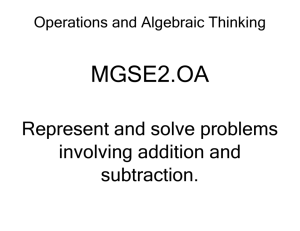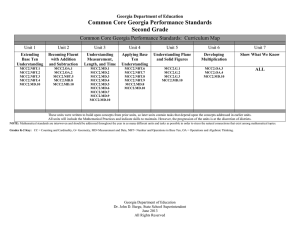Troup County School System
advertisement
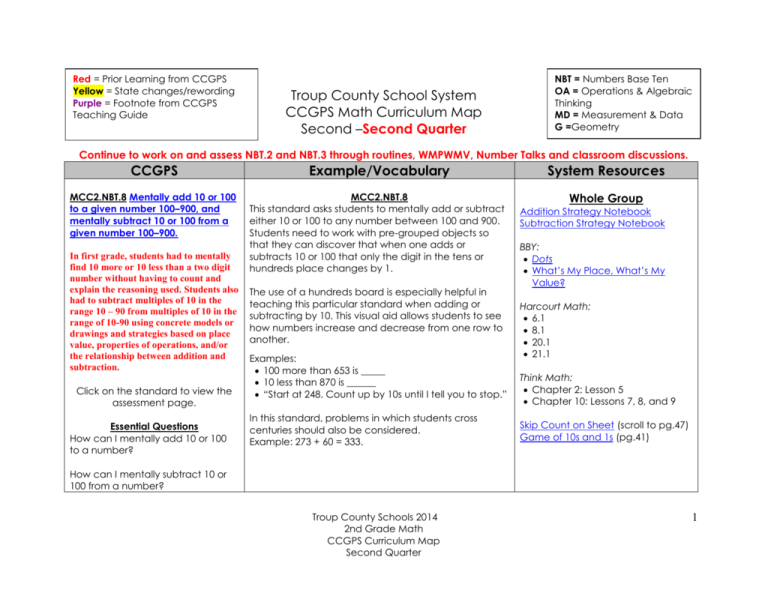
Red = Prior Learning from CCGPS Yellow = State changes/rewording Purple = Footnote from CCGPS Teaching Guide Troup County School System CCGPS Math Curriculum Map Second –Second Quarter NBT = Numbers Base Ten OA = Operations & Algebraic Thinking MD = Measurement & Data G =Geometry Continue to work on and assess NBT.2 and NBT.3 through routines, WMPWMV, Number Talks and classroom discussions. CCGPS Example/Vocabulary MCC2.NBT.8 Mentally add 10 or 100 to a given number 100–900, and mentally subtract 10 or 100 from a given number 100–900. MCC2.NBT.8 This standard asks students to mentally add or subtract either 10 or 100 to any number between 100 and 900. Students need to work with pre-grouped objects so that they can discover that when one adds or subtracts 10 or 100 that only the digit in the tens or hundreds place changes by 1. In first grade, students had to mentally find 10 more or 10 less than a two digit number without having to count and explain the reasoning used. Students also had to subtract multiples of 10 in the range 10 – 90 from multiples of 10 in the range of 10-90 using concrete models or drawings and strategies based on place value, properties of operations, and/or the relationship between addition and subtraction. Click on the standard to view the assessment page. Essential Questions How can I mentally add 10 or 100 to a number? The use of a hundreds board is especially helpful in teaching this particular standard when adding or subtracting by 10. This visual aid allows students to see how numbers increase and decrease from one row to another. Examples: 100 more than 653 is _____ 10 less than 870 is ______ “Start at 248. Count up by 10s until I tell you to stop.” In this standard, problems in which students cross centuries should also be considered. Example: 273 + 60 = 333. System Resources Whole Group Addition Strategy Notebook Subtraction Strategy Notebook BBY: Dots What’s My Place, What’s My Value? Harcourt Math: 6.1 8.1 20.1 21.1 Think Math: Chapter 2: Lesson 5 Chapter 10: Lessons 7, 8, and 9 Skip Count on Sheet (scroll to pg.47) Game of 10s and 1s (pg.41) How can I mentally subtract 10 or 100 from a number? Troup County Schools 2014 2nd Grade Math CCGPS Curriculum Map Second Quarter 1 CCGPS Example/Vocabulary System Resources MCC2.NBT.8 MCC2.NBT.8 MCC2.NBT.8 Learning Village: Where Am I on a Number Line Revisited Base Ten Pictures Revisited pg. 52 Vocabulary add/addition subtract/subtraction mentally Other Lessons: +10 Skip Counting Paths Add and Subtract 100 on the Number Line Differentiation Activities Hands-On Standards: Adding 10 or 100 Lesson 8 Subtracting 10 or 100 Lesson 58 Learning Village: What’s My Number? Revisited Shake, Rattle, and Roll Revisited Take 100 Revisited What’s My Number pg. 32 Other Lessons: Race Around (+10) Ver.1 Race Around (+10) Ver.2 Race Around (-10) Activities for Differentiation Plus or Minus Stay Same game (pg.16) Click here for other lessons and assessments Troup County Schools 2014 2nd Grade Math CCGPS Curriculum Map Second Quarter 2 CCGPS Example/Vocabulary MCC2.NBT.5 Fluently add and subtract within 100 using strategies based on place value, properties of operations, and/or the relationship between addition and subtraction. MCC2.NBT.5 The standard algorithm for addition and subtraction is not taught in second grade. This standard calls for students to use pictorial representations or strategies to find the solution. Students are able to demonstrate fluency when they are accurate (answer correctly), efficient (basic facts computed within 4-5 seconds) and flexible (use strategies such as decomposing numbers to make ten, using properties of operations, etc.). In first grade, students had to add within 100, including adding a two-digit number and a one-digit number, and addition a two-digit number and a multiple of 10, using concrete models or drawings and strategies based on place value, properties of operations, and/or the relationship between addition and subtraction. Misconception Document: NBT.5-9 Click on the standard to view the assessment page. Essential Questions What strategy or strategies work best for me when I am adding two digit numbers? What strategy or strategies work best for me when I am subtracting two digit numbers? Examples of Addition Strategies for 67 + 25: Place Value Strategy: I broke both 67 and 25 into tens and ones. 6 tens plus 2 tens equals 8 tens. Then I added the ones. 7 ones plus 5 ones equals 12 ones. I then combined my tens and ones. 8 tens plus 12 ones equals 92. Commutative Property: I broke 67 and 25 into tens and ones so I had to add 60 + 7 + 20 + 5. I added 60 and 20 first to get 80. Then I added 7 to get 87. Then I added 5 more. My answer is 92. Counting On and Decomposing A Number Leading to Ten: I wanted to start with 67 and then break 25 apart. I started with 67 and counted on to my next ten. 67 + 3 gets me to 70. I then took away three from 25 which gave me 22. I then added 2 more to 70 to get 72. I then added my 20 and got to 92. Troup County Schools 2014 2nd Grade Math CCGPS Curriculum Map Second Quarter System Resources Whole Group Addition Strategy Notebook Subtraction Strategy Notebook BBY: Dots What’s My Place, What’s My Value? Harcourt Math: 4.1, 4.5 (Properties of Operations) 6.1, 8.1 (Place Value) 5.2, 5.3, 5.4 (Relating + & -) Think Math: Chapter 1: Lessons 4, 5, 6, & 7 Chapter 2: Lesson 5 Chapter 8: Lesson 3 Learning Village: Different Paths, Same Destination pg. 40 Addition Strategies pg. 84 Multi-digit Addition Strategies pg. 79 Multi-digit Addition Strategies Revisited pg. 81 Subtraction with Regrouping pg. 98 3 CCGPS Example/Vocabulary MCC2.NBT.5 MCC2.NBT.5 Examples of Subtraction Strategies for 63 – 32: Relationship Between Addition and Subtraction: I broke apart both 63 and 32 into tens and ones. I know that 2 plus 1 equals 3, so I have 1 left in the ones place. I know that 3 plus 3 equals 6, so I have a 3 in my tens place. My answer has a 1 in the ones place and 3 in the tens place, so my answer is 31. Adding Up From Smaller Number to Larger Number: 32+8 = 40, 40+20 = 60, 60+3 = 63 so… 8+20+ 3 = 31 Incremental Subtracting: 63 – 3 = 60, 60 – 10 = 50, 50 – 10 = 40, 40 – 8 = 32 so……. 3 + 10 + 10 + 8 = 31 Subtraction by Place Value: 63 – 30 = 33, 33 – 2 gives 31 Here is an example of using an empty number line as a visual for the problem 72 – 39. System Resources MCC2.NBT.5 Other Lessons: 2 Digit Addition Split 2 Digit Subtraction Split Four in a Row with Near Doubles (Version 2) Four in a Row with Near Doubles (Version 3) Base Ten Addition Base Ten Subtraction Arrow Cards (scroll to pg.36) How Far to 100 (scroll to pg. 42) Differentiation Activities Learning Village: Take 100 pg. 78 Number Destinations pg. 45 Mental Math pg. 68 Other Lessons: Close to 100 Keep on Doubling Number Wheel Spin Vocabulary place value properties of operations relationship between addition and subtraction fact families Troup County Schools 2014 2nd Grade Math CCGPS Curriculum Map Second Quarter Activities for Differentiation Click here for other lessons and assessments 4 CCGPS MCC2.NBT.6 Add up to four twodigit numbers using strategies based on place value and properties of operations. Example/Vocabulary MCC2.NBT.6 This standard asks students to add up to 4 two-digit numbers by applying place value strategies and properties of operations. Example: 43 + 34 + 57 + 24 = ____ In first grade, students had to solve addition word problems that called for addition of three whole numbers whose sum is less than or equal to 20. System Resources Whole Group Addition Strategy Notebook BBY: Dots Harcourt Math: TE 173A - Getting Started TE 175A - Getting Started TE 179A - Getting Started Think Math: Chapter 8: Lesson 6 Chapter 10: Lesson 6 Click on the standard to view the assessment page. Misconception Document: NBT.5-9 Learning Village: Base Ten Pictures Revisited pg. 52 Other Lessons: Make 100 Beat Calculator (pg.92) Essential Questions Hands-On Standards: Adding Two-Digit Numbers Lesson 6 Learning Village: Take 100 Revisited pg. 75 Toll Bridge Puzzle Activities for Differentiation Differentiation Activities What strategies can I use to add two-digit numbers? Vocabulary add/addition two-digit number strategy place value properties of operations Troup County Schools 2014 2nd Grade Math CCGPS Curriculum Map Second Quarter Click here for other lessons and assessments 5 CCGPS MCC2.NBT.9 Explain why addition and subtraction strategies work, using place value and the properties of operations. Explanations may be supported by drawings or objects. In first grade, students had to use addition and subtraction strategies and explain the reasoning used. Click on the standard to view the assessment page. Misconception Document: NBT.5-9 Essential Questions How can I use objects, pictures, or words to explain why addition works? Example/Vocabulary MCC2.NBT.9 This standard calls for students to explain using concrete objects, pictures and words (oral or written) to explain why addition or subtraction strategies work. The expectation is that students apply their knowledge of place value and the properties of operations in their explanation. Students should have the opportunity to solve problems and then explain why their strategies work. Example: There are 36 birds in the park. 25 more birds arrive. How many birds are there? Solve the problem and show your work. Student 1: I broke 36 and 25 into tens and ones and then added them. 30 + 6 + 20 + 5. I can change the order of my numbers, so I added 30 + 20 and got 50. Then I added on 6 to get 56. Then I added 5 to get 61. This strategy works because I broke all the numbers up by their place value. Student 2: I used place value blocks and made a pile of 36. Then I added 25. I had 5 tens and 11 ones. I had to trade 10 ones for 1 10. Then I had 6 tens and 1 one. That makes 61. This strategy works because I added up the tens and then added up the ones and traded if I had more than 10 ones. System Resources MCC2.NBT.9 Whole Group Have students record what they are doing with pictures, numbers, and words in math journals. Two Digit Computation Differentiation Activities Learning Village: Take 100 Revisited pg. 75 Activities for Differentiation Click here for other lessons and assessments How can I use objects, pictures, or words to explain why subtraction works? Troup County Schools 2014 2nd Grade Math CCGPS Curriculum Map Second Quarter 6 CCGPS MCC2.NBT.9 Example/Vocabulary MCC2.NBT.9 Students should also have experiences examining strategies and explaining why they work. Also include incorrect examples for students to examine. Example: One of your classmates solved the problem 56 - 34 = __ by writing ―I know that I need to add 2 to the number 4 to get 6. I also know that I need to add 20 to 30 to get 20 to get to 50. So, the answer is 22. Is their strategy correct? Explain why or why not? One of your classmates solved the problem 25 + 35 by adding 20 + 30 + 5 + 5. Is their strategy correct? Explain why or why not? System Resources MCC2.NBT.9 Click here for other lessons and assessments Vocabulary add/addition subtract/subtraction strategy place value properties of operations Troup County Schools 2014 2nd Grade Math CCGPS Curriculum Map Second Quarter 7 CCGPS ONLY TEACH ONE STEP THIS QUARTER. TWO STEP COMES NEXT QUARTER MCC2.OA.1 Use addition and subtraction within 100 to solve one and two step word problems by using drawings and equations with a symbol for the unknown number to represent the problem. Problems include contexts that involve adding to, taking from, putting together/taking apart (part/part/whole) and comparing with unknowns in all positions. (See Table 1) Click here for Table 1 Addition and subtraction within 5, 10, 20, 100, or 1000. Addition or subtraction of two whole numbers with whole number answers, and with sum or minuend in the range 0-5, 0-10, 0-20, or 0-100 respectively. Example: 8 + 2 = 10 is an addition within 10, 14 – 5 = 9 is a subtraction within 20, and 55 – 18 = 37 is a subtraction within 100. In first grade, students used addition and subtraction within 20 to solve word problems. They also used objects, drawings, and equations with a symbol for the unknown number to represent the problem. Example/Vocabulary MCC2.OA.1 This standard calls for students to add and subtract numbers within 100 in the context of one and two step word problems. Students should have ample experiences working on various types of problems that have unknowns in all positions, including: Result Unknown: There are 29 students on the playground. Then 18 more students showed up. How many students are there now? (29 + 18 =__) Change Unknown: There are 29 students on the playground. Some more students show up. There are now 47 students. How many students came? (29+ _ = 47) Start Unknown: There are some students on the playground. Then 18 more students came. There are now 47 students. How many students were on the playground at the beginning? (___ + 18 = 47) See Table 1 at the end of this document for more addition examples as well as subtraction examples. This standard also calls for students to solve one- and twostep problems using drawings, objects and equations. Students can use place value blocks or hundreds charts, or create drawings of place value blocks or number lines to support their work. Examples of one-step problems with unknowns in different places are provided in Table 1. Two step-problems include situations where students have to add and subtract within the same problem. One- Step Example: Some students were in the cafeteria. 24 more students came in. Now there are 60 students in the cafeteria. How many were in the cafeteria to start with? System Resources Whole Group BBY: Dots What’s My Place, What’s My Value? Think Math: Chapter 2: Lessons 7 and 9 Chapter 4: Lessons 1 and 2 Chapter 8: Lesson 10 Chapter 10: Lesson 7 Learning Village: Subtraction Story Problems pg. 105 Counting Mice pg. 113 Other Lessons: Close to 100 Add – Change Unknown Word Problems Add – Start Unknown Word Problem Take From – Change Unknown Word Problems Take From – Start Unknown Word Problems Change Unknown Powerpoint (thanks Lisa Whelan) More Add Word Prob Examples (thanks Lisa Whelan) What’s My Job Addition Poster What’s My Job Subtraction Poster What’s My Job Comparing Poster Click on the standard to view the assessment page. Troup County Schools 2014 2nd Grade Math CCGPS Curriculum Map Second Quarter 8 CCGPS Example/Vocabulary MCC2.OA.1 Essential Questions How do I know which operation to use in a one-step word problem? System Resources MCC2.OA.1 MCC2.OA.1 Student A: I thought, “What and 24 makes 60?” So, my equation for the problem is □ + 24 = 60. I used a number line to solve it. I started with 24. Then I took jumps of 10 until I got close to 60. I landed on 54. Then, I took a jump of 6 to get to 60. So, 10 + 10 + 10 + 6 = 36. What are some different situations in which we would subtract? Student B: I thought, “There are 60 total. I know about the 24. So, what is 60 – 24?” What are some different situations My equation for the problem is 60 – 24 = □. in which we would add? I used place value blocks to solve it. I started with 60 and took 2 tens away. I needed to take 4 more away. So, I broke up a ten into ten ones. Then, I took 4 away. That Vocabulary left me with 36. So, 36 students were in the cafeteria at the beginning. 60 – 24 = 36 add adding to putting together subtract taking from taking apart comparing one-step two-step equation unknown symbol solve Differentiation Activities Hands-On Standards: Addition and Subtraction Lesson 1 Writing Number Sentences Lesson 2 Learning Village: Every Picture Tells a Story pg. 119 Other Lessons: Word Problems (One Step) Word Problems (Two Step) Wacky Word Problems Addition Word Problems Sub Word Problems Solve Story Problems (pg.20) Story Problem Centers (pg.45) Activities for Differentiation Click here for other lessons and assessments ] Troup County Schools 2014 2nd Grade Math CCGPS Curriculum Map Second Quarter 9 CCGPS MCC2.MD.5 Use addition and subtraction within 100 to solve word problems involving lengths that are given in the same units, e.g., by using drawings (such as drawings of rulers) and equations with a symbol for the unknown number to represent the problem. In first grade, students only solved word problems within 20. Click on the standard to view the assessment page. Essential Questions How can I solve word problems involving length? Example/Vocabulary MCC2.MD.5 This standard asks students to apply the concept of length to solve addition and subtraction word problems with numbers within 100. It is important that word problems stay within the same unit of measure. Students can use drawings, rulers, pictures, and/or physical objects to solve the problem. They may also use equations. It is important to note that equations may vary depending on students’ interpretation of the task. Example: In P.E. class Kate jumped 14 inches. Mary jumped 23 inches. How much farther did Mary jump than Kate? Write an equation and then solve the problem. Student A: My equation is 14+___ = 23 since I am trying to find out the difference between Kate and Mary’s jumps. I used place value blocks and counted out 14. Then I added blocks until I got to 23. I needed to add 9 blocks. Student B: My equation is 23 – 14 = ___. I drew a number line. I started at 23. I moved back to 14 and counted how far I moved. I moved back 9 spots. Mary jumped 9 more inches than Kate. System Resources Whole Group BBY: Dots What’s My Place, What’s My Value? Harcourt Math: no match Other Lessons: Linear Measurement Word Problems More Length Word Problems Arm Span Problems (scroll to pg.60) Differentiation Activities Learning Village: Solving Problems on a Number Line Activities for Differentiation Click here for other lessons and assessments Vocabulary length equation Troup County Schools 2014 2nd Grade Math CCGPS Curriculum Map Second Quarter 10 CCGPS MCC2.MD.6 Represent whole numbers as lengths from 0 on a number line diagram with equally spaced points corresponding to the numbers 0, 1, 2, ..., and represent whole-number sums and differences within 100 on a number line diagram. During this quarter continue number line to include numbers 0 to 100. Example/Vocabulary MCC2.MD.6 This standard asks students to represent their thinking when adding and subtracting within 100 by using a number line. Students should build on their experience from first quarter using evenly spaced points on a number line to an open number line. Example: Karen has a rope that is 82 inches long. She cuts off 37 inches to give to her friend for a jump rope. How many inches does she have now? System Resources Whole Group BBY: What’s My Place, What’s My Value? Harcourt Math: no match Think Math: Chapter 1: Lessons 4, 5, 6, and 7 Chapter 11: Lesson 1 Human Number Line (scroll to pg.69) Creating A Number Line (scroll to pg.64) Adding on Number Line (pg.59) Solve Word Problems Using # line (pg.67) This is new learning. Click on the standard to view the assessment page. Differentiation Activities Essential Questions How do I create a number line that can help me solve addition and subtraction problems? Vocabulary sum difference number line Hands-On Standards: Whole Numbers as Lengths on a Number Line Lesson 6 Learning Village: Where Am I On a Number Line? pg.27 Solving Problems on a Number Line Activities for Differentiation Click here for other lessons and assessments Troup County Schools 2014 2nd Grade Math CCGPS Curriculum Map Second Quarter 11 CCGPS MCC2.MD.10 Draw a picture graph and a bar graph (with single-unit scale) to represent a data set with up to four categories. Solve simple put-together, take-apart, and compare problems using information presented in a bar graph. Example/Vocabulary MCC2.MD.10 This standard calls for students to work with categorical data by organizing, representing and interpreting data. Students should have experiences posing a question with 4 possible responses and then work with the data that they collect. Example: Students pose a question and the 4 possible responses. Which is your favorite flavor of ice cream: Chocolate, vanilla, strawberry, or cherry? See Table 1 – Click here In first grade, students had to organize, represent, and interpret data with up to three categories; ask and answer questions about the total number of data points, how many in each category, and how many more or less are in one category than in another. Students display their data using a picture graph or bar graph using a single unit scale. System Resources Whole Group BBY: Dots Harcourt Math: TE 45B - Alternative Teaching Strategy TE 47B Advanced Learning & Language Arts Connection 3.5 3.6 Think Math: Chapter 5: Lessons 2, 4, and 5 Other Lessons: My Favorite Holiday Song Graph Collecting and Representing Data Build It Graph It Unit (scroll through this unit and find great blackline masters for creating graphs) Click on the standard to view the assessment page. What Pattern Block???? (scroll to pg.76) Differentiation Activities Other Lessons: Button Bar Graph Button Pictograph Essential Questions How can I use a picture graph to organize data and answer questions? How can I use a bar graph to organize data and answer questions? picture graph data set categories horizontal Vocabulary bar graph scale title vertical Troup County Schools 2014 2nd Grade Math CCGPS Curriculum Map Second Quarter Activities for Differentiation Click here for other lessons and assessments 12 Standards for Mathematical Practice – 2nd Grade 1. Make sense of problems and persevere in solving them. 2. Reason abstractly and quantitatively. 3. Construct viable arguments and critique the reasoning of others. 4. Model with mathematics. 5. Use appropriate tools strategically. 6. Attend to precision. 7. Look for and make use of structure. 8. Look for and express regularity in repeated reasoning. In second grade, students realize that doing mathematics involves solving problems and discussing how they solved them. Students explain to themselves the meaning of a problem and look for ways to solve it. They may use concrete objects or pictures to help them conceptualize and solve problems. They may check their thinking by asking themselves, “Does this make sense?” They make conjectures about the solution and plan out a problem solving approach. Younger students recognize that a number represents a specific quantity. They connect the quantity to written symbols. Quantitative reasoning entails creating a representation of a problem while attending to the meanings of the quantities. Second graders begin to know and use different properties of operations and objects. Second graders may construct arguments using concrete referents, such as objects, pictures, drawings, and actions. They practice their mathematical communication skills as they participate in mathematical discussions involving questions like “How did you get that?”, “Explain your thinking,” and “Why is that true?” They not only explain their own thinking, but listen to others’ explanations. They decide if the explanations make sense and ask appropriate questions. In early grades, students experiment with representing problem situations in multiple ways including numbers, words (mathematical language), drawing pictures, using objects, acting out, making a chart or list, creating equations, etc. Students need opportunities to connect the different representations and explain the connections. They should be able to use all of these representations as needed. In second grade, students consider the available tools (including estimation) when solving a mathematical problem and decide when certain tools might be better suited. For instance, second graders may decide to solve a problem by drawing a picture rather than writing an equation. As children begin to develop their mathematical communication skills, they try to use clear and precise language in their discussions with others and when they explain their own reasoning. Second graders look for patterns. For instance, they adopt mental math strategies based on patterns (making ten, fact families, doubles). Students notice repetitive actions in counting and computation, etc. When children have multiple opportunities to add and subtract, they look for shortcuts, such as rounding up and then adjusting the answer to compensate for the rounding. Students continually check their work by asking themselves, “Does this make sense?” Troup County Schools 2014 2nd Grade Math CCGPS Curriculum Map Second Quarter 13 Table 1: Common Addition and Subtraction Situations.13 Add to Take from Put together/ take apart15 Compare16 Result Unknown Two bunnies sat on the grass. Three more bunnies hopped there. How many bunnies are on the grass now? 2+3=? Change Unknown Two bunnies were sitting on the grass. Some more bunnies hopped there. Then there were five bunnies. How many bunnies hopped over to the first two? 2+ ? = 5 Five apples are on the table. Three are red and the rest are green. How many apples are green? 3 + ? = 5, 5 – 3 = ? Start Unknown Some bunnies were sitting on the grass. Three more bunnies hopped there. Then there were five bunnies. How many bunnies were on the grass before? ?+3=5 Some apples were on the table. I ate two apples. Then there were three apples. How many apples were on the table before? ?–2=3 Total Unknown Three red apples and two green apples are on the table. How many apples are on the table? 3+2=? Addend Unknown Five apples are on the table. Three are red and the rest are green. How many apples are green? 3 + ? = 5, 5 – 3 = ? Difference Unknown (“How many more?” version): Lucy has two apples. Julie has five apples. How many more apples does Julie have than Lucy? Bigger Unknown (Version with “more”): Julie has three more apples than Lucy. Lucy has two apples. How many apples does Julie have? Both Addends Unknown14 Grandma has five flowers. How many can she put in her red vase and how many in her blue vase? 5 = 0 + 5, 5 = 5 + 0 5 = 1 + 4, 5 = 4 + 1 5 = 2 + 3, 5 = 3 + 2 Smaller Unknown (Version with “more”) Julie has three more apples than Lucy. Julie has five apples. How many apples does Lucy have? (“How many fewer?” version): Lucy has two apples. Julie has five apples. How many fewer apples does Lucy have than Julie? 2 + ? = 5, 5 – 2 = ? (Version with “fewer”) Lucy has 3 fewer apples than Julie. Lucy has two apples. How many apples does Julie have? 2 + 3 = ?, 3 + 2 = ? (Version with “fewer”) Lucy has 3 fewer apples than Julie. Julie has five apples. How many apples does Lucy have? 5 -3 = ?, ? + 3 = 5 Five apples were on the table. I ate two apples. How many apples are on the table now? 5–2=? Troup County Schools 2014 2nd Grade Math CCGPS Curriculum Map Second Quarter 14 Footnotes from Table 1: 13 6Adapted from Box 2‐4 of Mathematics Learning in Early Childhood, National Research Council (2009, pp. 32, 33). 14 These take apart situations can be used to show all the decompositions of a given number. The associated equations, which have the total on the left of the equal sign, help children understand that the = sign does not always mean makes or results in but always does mean is the same number as. 15 2Either addend can be unknown, so there are three variations of these problem situations. Both Addends Unknown is a productive extension of this basic situation, especially for small numbers less than or equal to 10. 16 For the Bigger Unknown or Smaller Unknown situations, one version directs the correct operation (the version using more for the bigger unknown and using less for the smaller unknown). The other versions are more difficult. First Grade Glossary: Addition and subtraction within 5, 10, 20, 100, or 1000. Addition or subtraction of two whole numbers with whole number answers, and with sum or minuend in the range 0‐5, 0‐10, 0‐20, or 0‐100, respectively. Example: 8 + 2 = 10 is an addition within 10, 14 – 5 = 9 is a subtraction within 20, and 55 – 18 = 37 is a subtraction within 100. Troup County Schools 2014 2nd Grade Math CCGPS Curriculum Map Second Quarter 15 Standard Additional Resources for Professional Development MCC2.NBT.8 BLAST Professional Development Video 2.NBT.5-9 Math Misconceptions 2.NBT.5-9 Math Videos – scroll down to addition and subtraction sections (all videos are excellent, just remember students are not using the standard algorithm to regroup in 2nd grade) BLAST Professional Development Video 2.NBT.5-9 Math Misconceptions 2.NBT.5-9 BLAST Professional Development Video 2.NBT.5-9 Math Misconceptions 2.NBT.5-9 BLAST Professional Development Video 2.NBT.5-9 Math Misconceptions 2.NBT.5-9 Teaching Student Centered Mathematics K-3, John Van de Walle and LouAnn Lovin, pages 310-321 MCC2.NBT.5 MCC2.NBT.6 MCC2.NBT.9 MCC2.MD.10 Troup County Schools 2014 2nd Grade Math CCGPS Curriculum Map Second Quarter 16
